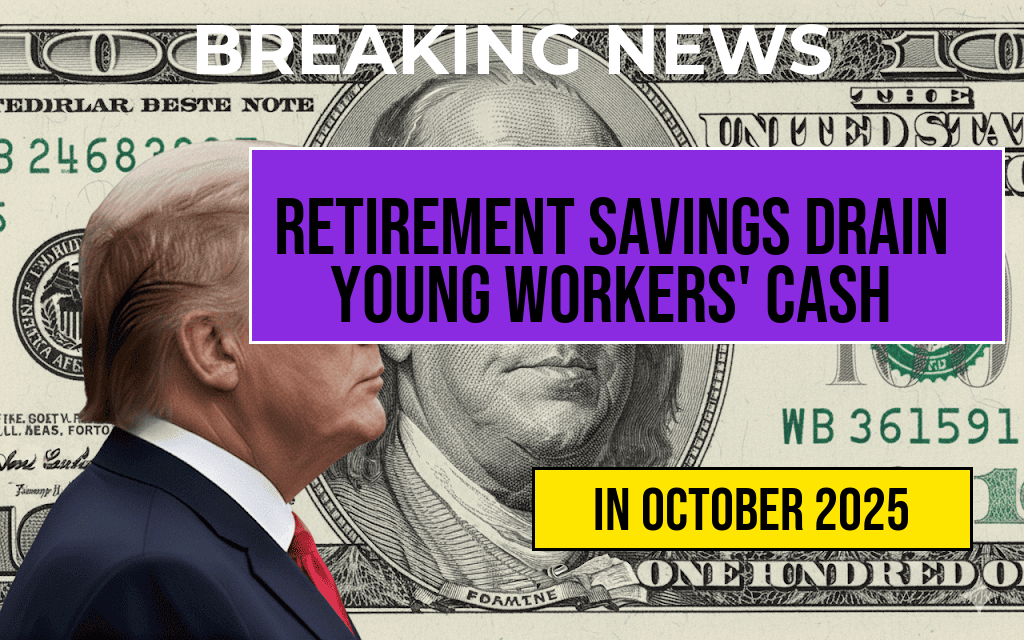Recent research reveals a startling trend among younger American workers: a significant portion of their disposable income is being diverted into a growing financial drain known as the “financial vortex,” which is contributing to a substantial retirement savings shortfall. According to a comprehensive survey conducted by the National Financial Wellbeing Institute, nearly 42% of individuals aged 25 to 40 report allocating more than a third of their spare cash toward debt repayment, emergency expenses, and non-retirement investments. This pattern leaves many struggling to build the necessary nest egg for their future, with experts warning that the persistent cycle could have long-term repercussions for retirement security across the nation. The phenomenon underscores the complex interplay between rising living costs, stagnant wages, and the proliferation of consumer debt, which collectively threaten to erode decades of financial progress for a generation already burdened with economic uncertainties.
The Roots of the Financial Vortex
Growing Debt and Rising Living Expenses
Over the past decade, American households have faced mounting financial pressures. Student loan debt has soared past $1.7 trillion, while housing costs continue to climb in urban centers across the country. Simultaneously, inflation has outpaced wage growth, leaving many workers with less disposable income after essential expenses. The National Financial Wellbeing Institute’s report indicates that 58% of younger respondents feel “overwhelmed” by their monthly bills, prompting them to prioritize immediate financial needs over long-term savings.
The Role of Consumer Debt
Credit card debt is a significant contributor to the financial vortex. According to the Federal Reserve, credit card balances have increased by 15% over the last two years, with the average debt per household reaching approximately $5,300. High-interest rates exacerbate the problem, forcing borrowers into a cycle of minimum payments that barely chip away at the principal. For many, this means diverting funds that could otherwise be directed toward retirement accounts or investments, effectively draining their capacity to save for the future.
The Impact on Retirement Preparedness
Shortfall in Retirement Savings
Data from the Employee Benefit Research Institute highlights a concerning trend: only about 65% of workers aged 25–40 have begun contributing to a retirement plan, and those who do often fall short of recommended savings benchmarks. The “financial vortex” exacerbates this issue by siphoning off funds that could go into 401(k)s or IRAs. As a result, many younger workers are on track to retire with less than half the amount needed to sustain their preferred lifestyle, increasing reliance on Social Security and other safety nets that may be insufficient to cover future expenses.
Long-term Consequences
Experts warn that persistent financial strain during early working years can have cascading effects. Reduced savings hinder the ability to weather unexpected expenses, such as medical emergencies or job loss, leading to further borrowing and financial stress. This cycle not only hampers individual retirement prospects but also poses broader economic risks, including increased dependence on government assistance programs and decreased consumer spending power.
Addressing the Drain: Policy and Personal Strategies
Policy Initiatives
- Expanding access to employer-sponsored retirement plans, especially for gig and part-time workers
- Implementing student debt relief programs to reduce long-term liabilities
- Promoting financial literacy programs that emphasize budgeting, debt management, and early retirement planning
Individual Actions
- Prioritizing debt repayment strategies such as snowball or avalanche methods
- Establishing emergency funds covering three to six months of living expenses
- Automating retirement contributions to ensure consistent savings regardless of short-term financial fluctuations
Looking Ahead
| Age Group | Average Savings Shortfall | Percentage at Risk |
|---|---|---|
| 25-34 | $30,000 | 70% |
| 35-44 | $65,000 | 65% |
Addressing the “financial vortex” requires coordinated efforts across policy frameworks and individual behaviors. With early intervention and a focus on financial resilience, it’s possible to stem the tide of retirement savings deficits and empower younger generations to secure their futures. Resources like Investopedia’s retirement planning guides and Consumer Financial Protection Bureau’s resources can serve as valuable starting points for those seeking to regain control over their financial trajectories.
Frequently Asked Questions
What is the main issue highlighted in the article regarding younger workers’ retirement savings?
The article discusses a retirement savings shortfall caused by the financial vortex, which drains up to 42% of younger workers’ spare cash, jeopardizing their ability to save adequately for retirement.
How does the financial vortex impact younger workers’ finances?
The financial vortex refers to various financial pressures such as high living costs, debt, and unexpected expenses that consume a significant portion of younger workers’ spare cash, leaving less available for retirement savings.
What percentage of younger workers’ spare cash is lost due to the financial vortex?
The article states that up to 42% of younger workers’ spare cash is drained by the financial vortex, reducing their ability to contribute to retirement savings.
Why is the current retirement savings shortfall concerning for younger workers?
The shortfall is concerning because it can lead to inadequate funds during retirement, increasing the risk of financial insecurity in later years and making long-term financial planning more challenging.
What strategies can younger workers adopt to mitigate the effects of the financial vortex and improve their retirement savings?
Young workers can focus on creating a budget, reducing unnecessary expenses, prioritizing automatic contributions to retirement accounts, and seeking financial advice to better manage their finances and counteract the financial vortex.

Leave a Reply